Caryn
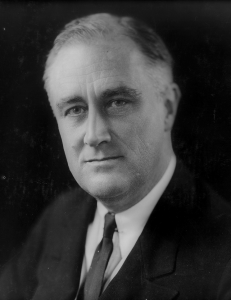
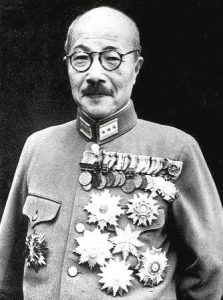 A sneak attack…not something that happens overnight. That kind of attack takes planning. Relations between the United States and Japan had not been good, but now with Japan’s occupation of Indo-China and the implicit menacing of the Philippines, an American protectorate, they were deteriorating rapidly. The Americans had retaliated by seizing of all Japanese assets in the United States. That action was followed by the closing of the Panama Canal to Japanese shipping. In September 1941, President Roosevelt issued a statement, drafted by British Prime Minister Winston Churchill, that threatened war between the United States and Japan should the Japanese encroach any farther on territory in Southeast Asia or the South Pacific.
A sneak attack…not something that happens overnight. That kind of attack takes planning. Relations between the United States and Japan had not been good, but now with Japan’s occupation of Indo-China and the implicit menacing of the Philippines, an American protectorate, they were deteriorating rapidly. The Americans had retaliated by seizing of all Japanese assets in the United States. That action was followed by the closing of the Panama Canal to Japanese shipping. In September 1941, President Roosevelt issued a statement, drafted by British Prime Minister Winston Churchill, that threatened war between the United States and Japan should the Japanese encroach any farther on territory in Southeast Asia or the South Pacific.
The Japanese were keen to wield more power on the people of the earth. To do that, they had to take down the biggest super power, the United States of America. And to protect themselves, they needed to take Hawaii out of the hands of the United States, because it was a gateway in the Pacific that they couldn’t afford to have in the hands of the Allies. On September 24, 1941, the Japanese consul in Hawaii was instructed to divide Pearl Harbor into five zones, calculate the number of battleships in each zone, and report the findings back to Japan. They were preparing for the attack they had planned for December.
The Japanese military had long dominated Japanese foreign affairs. The official negotiations between the United States secretary of state and his Japanese counterpart to ease tensions were still ongoing, but Hideki Tojo, the minister of war who would soon be prime minister, had no intention of withdrawing from captured territories…even if the negotiations required it. He also decided that the American “threat” of war as an ultimatum, and he made plans to attack first in a Japanese-American confrontation: the bombing of Pearl Harbor.
As the plans began to gear up, Japan didn’t know that the United States had intercepted the message. Most unfortunate, was the fact that the message was sent back to Washington for decrypting. There were not a lot of 
 flights east, so the message was sent via sea. That process took more time. When it finally arrived at the capital, staff shortages and other priorities further delayed the decryption. When the message was finally unscrambled in mid-October, it was dismissed as being of no great consequence. It was a huge error on the part of the American intelligence community, and on December 7th, everyone would know that.
flights east, so the message was sent via sea. That process took more time. When it finally arrived at the capital, staff shortages and other priorities further delayed the decryption. When the message was finally unscrambled in mid-October, it was dismissed as being of no great consequence. It was a huge error on the part of the American intelligence community, and on December 7th, everyone would know that.
 I have never traveled to what is supposed to be one of the most romantic cities in the world…Venice, in Italy, but like most people, I find the city, and especially the buildings to be very beautiful. The bridges in the city are especially beautiful, but some may be very misunderstood…as it turns out. One such “misunderstood” bridge is the Bridge of Sighs. This bridge cannot easily be visited on foot because it is a part of a government prison facility built on the waves near the harbor of the city, but is easily accessible via boats that are constantly flowing under it.
I have never traveled to what is supposed to be one of the most romantic cities in the world…Venice, in Italy, but like most people, I find the city, and especially the buildings to be very beautiful. The bridges in the city are especially beautiful, but some may be very misunderstood…as it turns out. One such “misunderstood” bridge is the Bridge of Sighs. This bridge cannot easily be visited on foot because it is a part of a government prison facility built on the waves near the harbor of the city, but is easily accessible via boats that are constantly flowing under it.
The Bridge of Sighs was built in the 17th century. It is a fully enclosed bridge made of white limestone, and its beauty has caught the attention of many, including the famous English nobleman and poet Lord Byron who told in one of his poems in the 19th century, about the bridge being the last point where condemned prisoners could see the beautiful city of Venice before they were brought to their executioner. That description is very different from the one that is more accepted by tourists, and possibly the tourism industry, who have portrayed it as the sighs of lovers, rather than the sighs of the condemned.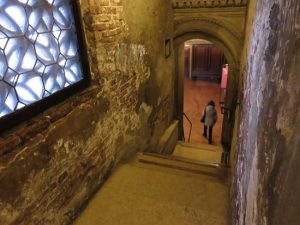
What many tourists, and possible some of the citizens don’t realize is that even centuries after it was built, Bridge of Sighs is still the part of the same prison complex that connects the main building of New Prison (Prigioni Nuove), to the nearby interrogation rooms located in the Doge’s Palace. Of course, the bridge is no longer used in the capacity of transport of maximum security prisoners, but is instead used by small-time offenders who are residing in this low-security prison. The fame of the bridge as the final point of the freedom of the prisoners may have come from the early history of Venice, when its prison was the place of summary executions and where inquisitions were indeed practiced…well before the bridge was ever built.
The Bridge of Sighs was built over the Rio di Palazzo between 1600 and 1603 by the instructions of the architect Antonio Contin, nephew of famous Antonio da Ponte who also designed one of the most popular 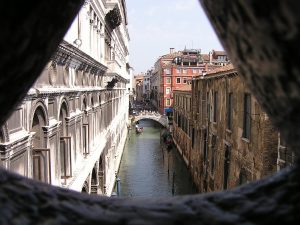 bridges in all of Venice…the Rialto Bridge. Antonio Contin designed this 11 meters long bridge to have a single arch, detailed and stylish outdoor decorations made from Istrian stone, and two windows barred with white stone bars on both sides of the walking chamber. These days, the only way to personally visit the Bridge of Sighs is to take part of “Secret Itinerary” (Itinerari Segreti) tour that is organized by the Doge Palace. The tour is only held between June and September and lasts around 90 minutes, it is done only in Italian and includes visiting of the several famous parts of the prison, such as its antique cells, torture chambers, other rooms, and of course, the Bridge of Sighs, as well. It is much easier to see the famous bridge from the water below, but you would not get to see the inside, of course.
bridges in all of Venice…the Rialto Bridge. Antonio Contin designed this 11 meters long bridge to have a single arch, detailed and stylish outdoor decorations made from Istrian stone, and two windows barred with white stone bars on both sides of the walking chamber. These days, the only way to personally visit the Bridge of Sighs is to take part of “Secret Itinerary” (Itinerari Segreti) tour that is organized by the Doge Palace. The tour is only held between June and September and lasts around 90 minutes, it is done only in Italian and includes visiting of the several famous parts of the prison, such as its antique cells, torture chambers, other rooms, and of course, the Bridge of Sighs, as well. It is much easier to see the famous bridge from the water below, but you would not get to see the inside, of course.

 My nephew, Jason Sawdon, who is married to my niece, Jessi. They are perfect for each other. They are both very social, outgoing people, who are also all about family. Jason and Jessi have a wonderful little girl named Adelaide Ione…named after two grandmothers. Jason was born in in Michigan, where his family still lives. For some reason, he found himself in Wyoming, where he met his future wife…my niece, Jessi. It was a match made in Heaven, and we all find ourselves so impressed with the obvious love and caring he has for Jessi. He encourages her and lifts her up, always making her feel special. It is something we have all witnessed, and something we all love that about him.
My nephew, Jason Sawdon, who is married to my niece, Jessi. They are perfect for each other. They are both very social, outgoing people, who are also all about family. Jason and Jessi have a wonderful little girl named Adelaide Ione…named after two grandmothers. Jason was born in in Michigan, where his family still lives. For some reason, he found himself in Wyoming, where he met his future wife…my niece, Jessi. It was a match made in Heaven, and we all find ourselves so impressed with the obvious love and caring he has for Jessi. He encourages her and lifts her up, always making her feel special. It is something we have all witnessed, and something we all love that about him.
Jason is a handyman…in his spare time. He can fix almost anything! My niece, Kellie Hadlock tells me that he fixes most of the stuff in her house, along with her brother, Ryan Hadlock and her dad, Chris Hadlock. Kellie says, “He is always willing to help family and his friends. ALWAYS!” What better tribute to someone’s character than that. People who are there for one another are the best kind of people…and Jason is the best kind of people, for sure. Kellie is quite close to Jason and Jessi, and to their daughter, Adelaide. To her Jason is her big brother and he has been from the start! She says that they also feed her all the time, hahahahaha!! I don’t think that’s the only reason she loves them, however.
Maybe it’s the cop in Jason, or maybe it’s just they way he is, but he has been protective of all of us from the beginning! Kellie says that of her family, but we have all felt that about Jason. I remember a time when my son-in-law, Kevin Petersen’s dad, Dean had a accident in which his travel trailer was blown all over the ditch, and when my daughter, Kevin and my daughter, Corrie arrived at the scene, they didn’t know what to expect. It 
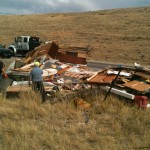 looked so bad, but Jason, a Wyoming Highway Patrolman, when he saw them, immediately went to them and reassured them that Dean was ok. There is nothing like having a first responder put their arm around you and let you know you are not alone, and everything will be ok…nothing like it at all. Your emotions are so raw and messed up in times like that, and you need someone to comfort you. Jason is great at his job and takes pride in doing everything right and with integrity, and that is the kind of patrolman we need in this world. Today is Jason’s birthday. Happy birthday Jason!! Have a great day!! We love you!!
looked so bad, but Jason, a Wyoming Highway Patrolman, when he saw them, immediately went to them and reassured them that Dean was ok. There is nothing like having a first responder put their arm around you and let you know you are not alone, and everything will be ok…nothing like it at all. Your emotions are so raw and messed up in times like that, and you need someone to comfort you. Jason is great at his job and takes pride in doing everything right and with integrity, and that is the kind of patrolman we need in this world. Today is Jason’s birthday. Happy birthday Jason!! Have a great day!! We love you!!
 As children, most of us have been on the receiving end of a form of “torture” that really isn’t exactly torture for most of us, but rather just good clean fun…provided that the torturer knows when to stop. My sisters and I were among the experts of our era…at least four of us were. The fifth sister, the middle one, Caryl Reed, was an “accomplished” victim…not because she chose to be the victim, but rather that she was the one we most loved to tickle. She was just such a great victim!! We would tickle her until she could hardly breathe, and then we would show some “mercy” and let her “live to be victimized another day.”
As children, most of us have been on the receiving end of a form of “torture” that really isn’t exactly torture for most of us, but rather just good clean fun…provided that the torturer knows when to stop. My sisters and I were among the experts of our era…at least four of us were. The fifth sister, the middle one, Caryl Reed, was an “accomplished” victim…not because she chose to be the victim, but rather that she was the one we most loved to tickle. She was just such a great victim!! We would tickle her until she could hardly breathe, and then we would show some “mercy” and let her “live to be victimized another day.”
I always thought my sisters, Cheryl Masterson, Alena Stevens, Allyn Hadlock, and I were very clever at coming up with something totally new…the Tickle Torture, but it turns out that Tickle Torture is an ancient form of actual torture. Who knew? Certainly not my sisters or me. Our form of torture, barely resembles the ancient form, or the form that still exists to this day among military circles. As it turns out, the tickle torture began in 260 BC, as far as anyone can tell, when the Han Dynasty appears to have implemented the technique as a reliable punishment that didn’t leave marks. It was used by 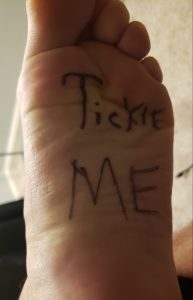 both the Ancient Romans and the Chinese. I have heard of some of the brutal forms of torture that the Romans used, and I suppose at first this seemed like one of the most humane forms of torture in their entourage. It seems that they would apply salt on the soles of feet and then have a goat lick it off. If you have ever had an animal lick your hand, you know that they usually have a rough tongue. At first, the torture must have been crazy in an extremely ticklish sort of way, and very likely the victim laughed until they could hardly breathe. As the torture continued, the rough tongue of the goat began to actually cause extreme pain…sometimes even lacerating the skin of the feet. The Chinese used this torture on the nobility because there was little evidence left behind and recovery was quick.
both the Ancient Romans and the Chinese. I have heard of some of the brutal forms of torture that the Romans used, and I suppose at first this seemed like one of the most humane forms of torture in their entourage. It seems that they would apply salt on the soles of feet and then have a goat lick it off. If you have ever had an animal lick your hand, you know that they usually have a rough tongue. At first, the torture must have been crazy in an extremely ticklish sort of way, and very likely the victim laughed until they could hardly breathe. As the torture continued, the rough tongue of the goat began to actually cause extreme pain…sometimes even lacerating the skin of the feet. The Chinese used this torture on the nobility because there was little evidence left behind and recovery was quick.
People have mixed feelings on tickling. Some like it, but some don’t. I have always been of the mind that if someone really hates it, it should not be done. Of course, the victims in those days had no choice, and I doubt if anyone really liked that kind of tickle torture. I guess that if a person really hates the tickle torture, they might be able to understand how some groups in history have come up with ways to turn it into an actual form of torture. In the actual torture, people might pass out, vomit, and some even died…at least it went that far in the Nazi concentration camps during World War II. I suppose that for anyone who lived through any of that or knew someone who did, the tickle torture would not be funny at all. Still, tickle torture was not as bad as some  of the other forms of torture used in ancient times, nor was it often as deadly as those other forms.
of the other forms of torture used in ancient times, nor was it often as deadly as those other forms.
Actual Tickle torture is still in use today too, and not just in various households across the world. Special operations forces may actually use it in interrogations, as a method of non-lethal torture to be employed by governments to gain information from a suspect. I don’t know how they would actually get any information for a victim, unless their form of torture took a painful turn, but then I’m not an interrogator, so maybe they know something I don’t. What I do know is that my sisters and I had many happy sessions of applying the tickle torture to our sister, Caryl.

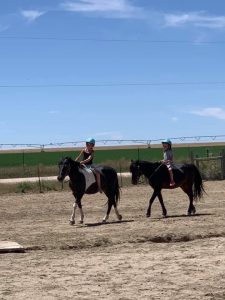 My grand niece, Hattie Parmely is the second child of my nephew Eric Parmely and his wife, Ashley. Hattie has two sisters and a brother, and the family lives on a farm west of Casper, Wyoming. Hattie is a gentle little girl who loves the animals on the farm…especially the babies. She and her siblings have learned so much about life in the short time they have lived. They have watched the miracle of birth and snuggled the little babies…from goats, to pigs, to chicks. They have helped muck stalls and watched the milking process…both goats and cows.
My grand niece, Hattie Parmely is the second child of my nephew Eric Parmely and his wife, Ashley. Hattie has two sisters and a brother, and the family lives on a farm west of Casper, Wyoming. Hattie is a gentle little girl who loves the animals on the farm…especially the babies. She and her siblings have learned so much about life in the short time they have lived. They have watched the miracle of birth and snuggled the little babies…from goats, to pigs, to chicks. They have helped muck stalls and watched the milking process…both goats and cows.
Hattie and her siblings, like all the other school children in the United States and much of the world, had a shortened year in school last year, because of Covid-19, and that has changed their lives in many ways. Like many parents, Hattie’s mom and dad have decided to re-evaluate their children’s education, and have come to the conclusion that with the inadequate and often corrupt way the schools are 
 teaching the children, as well as the virus that is still out there, the best way for them to properly educate their children is to do it at home. So, Hattie and her sister, Reagan and brother, Bowen will be studying under their mom, as will her sister, Maeve when she is older. The will have lots of “field trips” out to the barns too, of course, which doesn’t upset them at all. They love life on the farm, and they learn so much there too.
teaching the children, as well as the virus that is still out there, the best way for them to properly educate their children is to do it at home. So, Hattie and her sister, Reagan and brother, Bowen will be studying under their mom, as will her sister, Maeve when she is older. The will have lots of “field trips” out to the barns too, of course, which doesn’t upset them at all. They love life on the farm, and they learn so much there too.
Hattie is a girly girl, unless she is helping out in the barns, and I can imagine her doing that in a dress too. She likes frilly things, glitzy things, and colorful things, but she loves her cowboy boots too. In fact, she might be seen wearing a frilly dress with her cowboy boots. Still, these days, that is the style, so she is right there on that. I think Hattie likes being one of the middle children. She gets to have an older sister, and two younger siblings. It’s the best of both worlds…a sister to show her the ropes, and 
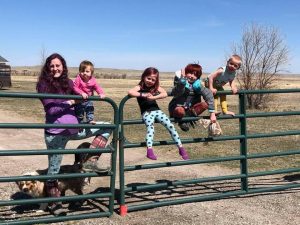 little ones to help teach.
little ones to help teach.
Hattie loves to ride her bike, and living in the country, they get to go on lots of bicycle rides without there being too many cars. She and her siblings ride as much as possible, and they are all very good at it. They love the outdoors, and being very active, and the country life is perfect for them to be able to do all their outdoor activities. Today is Hattie’s 6th birthday. Happy birthday Hattie!! Have a great day!! We love you!!
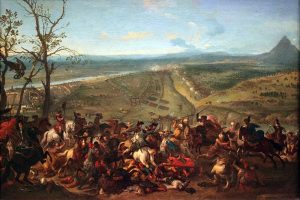 Different portions of an Austrian army, were scouting for forces of the Ottoman Empire, when they came across a band of gypsies near Karansebes…a small town in modern-day Romania. The gypsies were had been sitting around enjoying schnapps. The soldiers bought out their entire supply, and proceeded to get drunk. Now, as we all know, liquor is legendary for causing stupid fights, but this was about to become the most stupid fight of them all. On that September 19, 1788 night, the group of Austrian cavalrymen were in the woods looking for the enemy…Turkish forces in the area of Karansebes.
Different portions of an Austrian army, were scouting for forces of the Ottoman Empire, when they came across a band of gypsies near Karansebes…a small town in modern-day Romania. The gypsies were had been sitting around enjoying schnapps. The soldiers bought out their entire supply, and proceeded to get drunk. Now, as we all know, liquor is legendary for causing stupid fights, but this was about to become the most stupid fight of them all. On that September 19, 1788 night, the group of Austrian cavalrymen were in the woods looking for the enemy…Turkish forces in the area of Karansebes.
After buying the schnapps the soldiers began their booze-fest. A few hours later, which would be an eternity in “drunk time.” As we all know, that means they were very drunk. At this point, another group of foot soldiers came along and wanted to join the booze-fest. But the cavalrymen refused to share. Then they decided to build a makeshift wall around their booze…not the best idea. The second group of soldiers got angry and things gt heated. Before long the groups were fighting. The soldiers who had joined them tried to fool the cavalry into retreating, by telling them they saw Turkish soldiers. That plan backfired as everyone…soldier and cavalry alike…turned the violent stampede back towards camp.
As the Austrian officers tried to calm the men, the army’s mixed forces of Italians, Slovaks, and Hungarians, all of whom didn’t speak German very well, would have none of it. As they tried yelling stop…which is “Halt!” in German, the Italians, Slovaks, and Hungarians thought they were saying, “Allah!” which only intensified the brutal, confused madness. The rest of the camp woke up, and had no idea what was going on, so 100,000 men, who thought they heard a battle going on, they assumed they were under attack by Ottoman forces. They immediately jumped into combat and things got so out of hand, that the army literally brought out the big guns, fighting against their own men. The resulting confusion caused a great mix-up in the regiments, who became so terrified, literally of themselves, that they abandoned Karansebes altogether. The troops razed and pillaged towns for nearly 30 miles before the army recollected itself under new leadership.
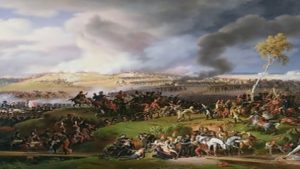
Two days after the battle, the Ottoman Empire troops finally arrived at Karansebes to find 10,000 dead and wounded Austrian soldiers. The Ottoman troops couldn’t believe their eyes. Their battle had already been won. The Austrian army, as well as the Italians, Slovaks, and Hungarians had handed the victory to the Ottomans, by almost entirely taking our their own people. The Ottoman troops laughed at their foolish enemies, after which they executed the survivors, and took the city without a fight. Chaos really never brings good results, and often in a riot situation, the very people they are supposedly trying to save are the ones who are hurt by the riots, often losing their own lives.

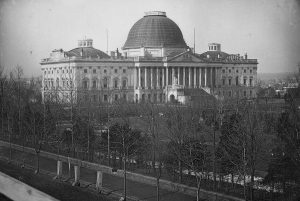 On September 11th, I wrote about the significance if the September 11th date and the terrorist attacks on New York City and the Pentagon, but there was another target that day. The attack on Washington DC was at first thought to be planned for the White House, but it was later determined that the attack was planned for the nation’s capitol building. I have wondered if that September 11th date could have a significance for the capitol too, so I did some research. Unfortunately, I have not been able to find a specific day that the groundbreaking at the capital took place.
On September 11th, I wrote about the significance if the September 11th date and the terrorist attacks on New York City and the Pentagon, but there was another target that day. The attack on Washington DC was at first thought to be planned for the White House, but it was later determined that the attack was planned for the nation’s capitol building. I have wondered if that September 11th date could have a significance for the capitol too, so I did some research. Unfortunately, I have not been able to find a specific day that the groundbreaking at the capital took place.
I did find out that on September 18, 1793, George Washington laid the cornerstone to the United States Capitol building. Now, I’m not a contractor, but it makes sense to me that from groundbreaking to cornerstone, could logically take a week…putting the possible groundbreaking on…you guessed it, September 11, 1793. The building itself would take nearly a century to complete, as architects came and went, the British set fire to it, and it was called into use during the Civil War. Nevertheless, the original groundbreaking took place before September 18, 1793. Today, the Capitol building, with its famous cast-iron dome and important collection of American art, is part of the Capitol Complex, which includes six Congressional office buildings and three Library of Congress buildings, all developed in the 19th and 20th centuries.
As we all know, the brave heroes of Flight 93 foiled that attack on September 11, 2001, which is why the US Capitol building was not destroyed or damaged. Those people saved the capitol building and somehow managed t crash their plane into a field…hitting no one on the ground. They knew that the other planes that had been hijacked, were not landing to have their demands met…they were being flown into buildings, and that meant that they were likely headed for the same fate. They knew that all they could do was to sacrifice their own lives to make sure that this attack did not succeed, and that is what they did, crashing it into a field near Shanksville, Pennsylvania. With a quick, “Let’s roll!!” they ran forward and fought with the terrorists, and while they weren’t able to get complete control of the plane, they made sure it didn’t reach it’s intended destination, and they saved the capital.
I can’t say, for sure, that September 11th was the date that they broke ground on the capital building, but in 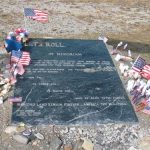
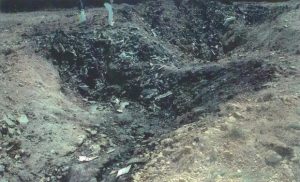 my mind, it makes sense that it was. And that makes it shocking to me. There were some days in Islamic history about September 11, but they were simply battles and such that took place, not the day that a city or place that was being attacked…also being the day that it was founded or had it’s groundbreaking. That makes it monumental, but in the third attack, they weren’t successful, and the plane crashed in a field. Maybe that was monumental too.
my mind, it makes sense that it was. And that makes it shocking to me. There were some days in Islamic history about September 11, but they were simply battles and such that took place, not the day that a city or place that was being attacked…also being the day that it was founded or had it’s groundbreaking. That makes it monumental, but in the third attack, they weren’t successful, and the plane crashed in a field. Maybe that was monumental too.
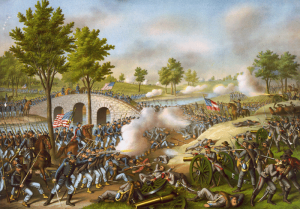 These days, with the many types of bombs nations use for warfare, it would be easy to annihilate an entire town, but during the Civil War…not so much. One bomb dropped on Hiroshima instantly killed 80,000 people. Of course that was on August 6, 1945, and not 1862. September 17, 1862 dawned slowly through the fog. It seemed like the start of a peacefully beautiful day, but looks can be deceiving. That morning, the soldiers were busy, trying to wipe away the dampness, when cannons began to roar and sheets of flame burst forth from hundreds of rifles. The bloodiest one-day battle in American History had begun. The Battle of Antietam was a 12-hour battle that swept across the rolling farm fields in western Maryland. It was this battle between North and South that changed the course of the Civil War, helped free over four million Americans, devastated Sharpsburg, and no other one-day battle would be as bloody.
These days, with the many types of bombs nations use for warfare, it would be easy to annihilate an entire town, but during the Civil War…not so much. One bomb dropped on Hiroshima instantly killed 80,000 people. Of course that was on August 6, 1945, and not 1862. September 17, 1862 dawned slowly through the fog. It seemed like the start of a peacefully beautiful day, but looks can be deceiving. That morning, the soldiers were busy, trying to wipe away the dampness, when cannons began to roar and sheets of flame burst forth from hundreds of rifles. The bloodiest one-day battle in American History had begun. The Battle of Antietam was a 12-hour battle that swept across the rolling farm fields in western Maryland. It was this battle between North and South that changed the course of the Civil War, helped free over four million Americans, devastated Sharpsburg, and no other one-day battle would be as bloody.
The Battle of Antietam marked the first invasion into the North by Confederate General Robert E Lee and the Army of Northern Virginia. It was the culmination of the Maryland Campaign of 1862. Southern armies were also advancing in Kentucky and Missouri, as the tide of war flowed north. After Lee’s dramatic victory at the Second Battle of Manassas during the last two days of August, he wrote to Confederate President Jefferson Davis that “we cannot afford to be idle.” Lee wanted to keep the pressure on in order to secure Southern independence through victory in the North; influence the Fall mid-term elections; obtain much-needed supplies; move the war out of Virginia, possibly into Pennsylvania; and to liberate Maryland, a Union state, but a slave-holding border state divided in its values.
Lee’s army splashed across the Potomac River and arrived in Frederick, Virginia, where he boldly divided his army to capture the Union garrison stationed at Harpers Ferry. A vital location on the Confederate lines of supply and communication back to Virginia; Harpers Ferry, Maryland was the gateway to the Shenandoah Valley. Lee’s link to the south was threatened by the 12,000 Union soldiers at Harpers Ferry. General Thomas Jonathan “Stonewall” Jackson and about half of the Army of Northern Virginia were sent to capture Harpers Ferry. The rest of the Confederates moved north and west toward South Mountain and Hagerstown, Maryland. The Confederate army soon retreated from South Mountain, and Lee considered returning to Virginia. However, with Jackson’s capture of Harpers Ferry on September 15th, Lee decided to make a stand at Sharpsburg.
Lee gathered his forces on the high ground west of Antietam Creek, with General James Longstreet’s command holding the center and the right, while Jackson’s men filled in on the left. The Confederate position was strengthened with the mobility provided by the Hagerstown Turnpike that ran north and south along Lee’s line. Still, the Potomac River behind them and only one crossing back to Virginia remained a risk. Lee and his men watched the Union army gather on the east side of Antietam Creek. Thousands of soldiers in blue marched into position throughout September 15th and 16th as General McClellan prepared for his attempt to drive Lee from Maryland. McClellan’s plan was to “attack the enemy’s left” and when “matters looked favorably,” attack the Confederate right, and “whenever either of those flank movements should be successful to advance our center.” As the opposing forces moved into position during the rainy night of September 16th, one Pennsylvanian remembered, “…all realized that there was ugly business and plenty of it just ahead.”
The twelve-hour battle began at dawn, and for the next seven hours, there were three major Union attacks on the Confederate left, moving from north to south. General Joseph Hooker’s command led the first Union assault. General Joseph Mansfield’s soldiers attacked second, followed by General Edwin Sumner’s men as McClellan’s plan broke down into a series of uncoordinated Union advances. The fierce battle raged across the Cornfield, East Woods, West Woods, and the Sunken Road as Lee shifted his men to withstand each of the Union thrusts. After clashing for over eight hours, Lee’s troops were pushed back, but not broken. Shockingly, over 15,000 soldiers were killed or wounded.
While the Union assaults were being made on the Sunken Road, a mile-and-a-half farther south, Union General Ambrose Burnside opened the attack on the Confederate right. He first sought to capture the bridge that would later bear his name, but a small Confederate force, positioned on higher ground, was able to delay Burnside for three hours. Finally, about 1:00pm Burnside captured the bridge, and then reorganized for two hours before moving forward across the difficult terrain…an unfortunate delay. When the advance did begin, it was turned back by Confederate General AP Hill’s reinforcements, who had arrived in the late afternoon from Harpers Ferry.
Neither flank of the Confederate army collapsed far enough for McClellan to advance his center attack, leaving a sizable Union force that never entered the battle. Despite an estimated 23,100 casualties of the nearly 100,000 engaged, both armies stubbornly held their ground as the sun set on the devastated landscape. The next day, September 18, 1862, the opposing armies gathered their wounded and buried their dead. That night 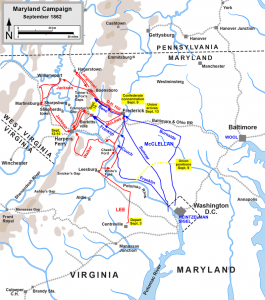 General Robert E Lee’s army withdrew back across the Potomac River to Virginia, ending his first invasion into the North. Lee’s retreat to Virginia provided President Abraham Lincoln the opportunity he had been waiting to issue the preliminary Emancipation Proclamation. Now, the Civil War had a dual purpose of preserving the Union and ending slavery, which the United States had been trying to end since it was founded.
General Robert E Lee’s army withdrew back across the Potomac River to Virginia, ending his first invasion into the North. Lee’s retreat to Virginia provided President Abraham Lincoln the opportunity he had been waiting to issue the preliminary Emancipation Proclamation. Now, the Civil War had a dual purpose of preserving the Union and ending slavery, which the United States had been trying to end since it was founded.
The Battle of Antietam was fought over an area of 12 square miles. Today the site consists of 184 acres containing approximately 5 miles of paved avenues. Located along the battlefield avenues to mark battle positions of infantry, artillery, and cavalry are many monuments, markers, and narrative tablets. Markers describe the actions at Turner’s Gap, Harpers Ferry, and Blackford’s Ford. Key artillery positions on the field of Antietam are marked by cannon. And 10 large-scale field exhibits at important points on the field indicate troop positions and battle action.
 Time flies by so fast. It seems completely impossible that 25 years could have passed since the day my daughter, Amy Royce and her husband, Travis said “I do” and began their life together. So much has changed since those days. Their children, Shai and Caalab are all grown up, and they have added Caalab’s girlfriend, Chloe Foster, to the family. The raised their children here is Casper, Wyoming, and then after Caalab’s high school graduation, the family moved to Bellingham, Washington. The area where they live is beautiful, and the weather is mild, which suits their family, especially Amy, who never liked our cold winters.
Time flies by so fast. It seems completely impossible that 25 years could have passed since the day my daughter, Amy Royce and her husband, Travis said “I do” and began their life together. So much has changed since those days. Their children, Shai and Caalab are all grown up, and they have added Caalab’s girlfriend, Chloe Foster, to the family. The raised their children here is Casper, Wyoming, and then after Caalab’s high school graduation, the family moved to Bellingham, Washington. The area where they live is beautiful, and the weather is mild, which suits their family, especially Amy, who never liked our cold winters.
I am always amazed when a couple reaches a big milestone anniversary, even though my own marriage has endured, as have those of both my girls, and many other people I know. Still, I am amazed, because as we all know, marriage is not for the faint of heart. It takes work, endurance, stubbornness, and is best handled with prayer. It also takes a knowledge of the kind of person you are, and the kind of person you want to spend your life with. At such a young age, I wonder how it is that anyone can have any  idea of who they are or who they want to be with, but it seems to me that more people are staying together these days than they were when I was a kid. Amy and Travis are two of the kind of people who knew that their spouse would be someone they could love forever, and they knew it at a very young age. They are so compatible, and they work together as a team. The ups and downs of life did not deter them from reaching the goal of “together forever!” Their home is filled with love, laughter, and harmony. They have chosen their spouse well, and I couldn’t be happier for them as they reach this milestone day…their Silver Anniversary.
idea of who they are or who they want to be with, but it seems to me that more people are staying together these days than they were when I was a kid. Amy and Travis are two of the kind of people who knew that their spouse would be someone they could love forever, and they knew it at a very young age. They are so compatible, and they work together as a team. The ups and downs of life did not deter them from reaching the goal of “together forever!” Their home is filled with love, laughter, and harmony. They have chosen their spouse well, and I couldn’t be happier for them as they reach this milestone day…their Silver Anniversary.
I know that the next 25 years will be for them, as sweet as the first 25 years have been. Their love is real and lasting. They surround themselves with beauty and love, and that makes their life peaceful and sweet. God has  richly blessed their union, and will continue to do so for the rest of their lives. Yes, time flies by so fast, and before we know it, 25 years have flown by…as if we weren’t looking, somehow. Our children are grown and have children of their own. They are off living their own lives and all I can think is how proud I am of them. They are successful, and in a lasting marriage. The make a great living, and have a beautiful home, where Travis loves to mow and care for the yard, and Amy loves to grow beautiful flowers to brighten their days. It is a home filled with their own special love. Today is Amy and Travis’ 25th wedding anniversary. Happy Silver Wedding Anniversary Amy and Travis!! Have a wonderful day!! We love you!!
richly blessed their union, and will continue to do so for the rest of their lives. Yes, time flies by so fast, and before we know it, 25 years have flown by…as if we weren’t looking, somehow. Our children are grown and have children of their own. They are off living their own lives and all I can think is how proud I am of them. They are successful, and in a lasting marriage. The make a great living, and have a beautiful home, where Travis loves to mow and care for the yard, and Amy loves to grow beautiful flowers to brighten their days. It is a home filled with their own special love. Today is Amy and Travis’ 25th wedding anniversary. Happy Silver Wedding Anniversary Amy and Travis!! Have a wonderful day!! We love you!!
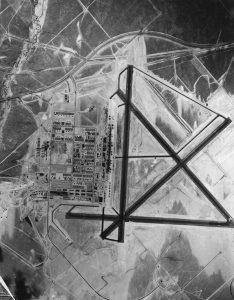
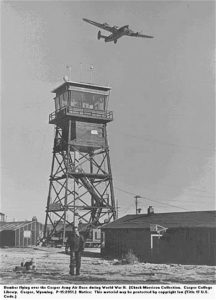 Prior to December 7, 1941, the United States had signed a Proclamation of Neutrality. They did not want to get pulled into World War II, any more than they had World War I and any of the other wars they were involved in. Still, I think everyone knew that it was inevitable…even before the Japanese attack. Early on the Sunday morning of December 7, 1941, the Japanese attack on Pearl Harbor, Hawaii, and almost simultaneously at other locations in the Pacific, would end any continued semblance of neutrality, and the United States prepared for war. The response to the attack was quick and decisive. The US Army Air Force (USAAF), under the command of Major General Henry Harley “Hap” Arnold was authorized to equip, man, and train itself into the world’s most powerful air force, and to do so quickly. The first order of business was to establish air force bases. By early 1942, the USAAF had committed to building scores of air bases across the United States. Everyone wanted to help, so a Chamber of Commerce delegation from Casper, Wyoming, traveled to Washington DC, to lobby for one of the proposed air bases. According to Joye Kading, longtime secretary at the Casper Army Air Base, they marketed the “zephyr wind” that whips around the western end of Casper Mountain as part of what made it a perfect location. The USAAF agreed.
Prior to December 7, 1941, the United States had signed a Proclamation of Neutrality. They did not want to get pulled into World War II, any more than they had World War I and any of the other wars they were involved in. Still, I think everyone knew that it was inevitable…even before the Japanese attack. Early on the Sunday morning of December 7, 1941, the Japanese attack on Pearl Harbor, Hawaii, and almost simultaneously at other locations in the Pacific, would end any continued semblance of neutrality, and the United States prepared for war. The response to the attack was quick and decisive. The US Army Air Force (USAAF), under the command of Major General Henry Harley “Hap” Arnold was authorized to equip, man, and train itself into the world’s most powerful air force, and to do so quickly. The first order of business was to establish air force bases. By early 1942, the USAAF had committed to building scores of air bases across the United States. Everyone wanted to help, so a Chamber of Commerce delegation from Casper, Wyoming, traveled to Washington DC, to lobby for one of the proposed air bases. According to Joye Kading, longtime secretary at the Casper Army Air Base, they marketed the “zephyr wind” that whips around the western end of Casper Mountain as part of what made it a perfect location. The USAAF agreed.
In March 1942, the US Army Corps of Engineers leased the old Casper City Hall at Center and Eighth streets in downtown Casper, in preparation for the construction of the new Army Air Base at Casper. The site they selected was a high, flat, sagebrush-covered terrace located nine miles west of town on US Highway 20-26 and adjacent to the Chicago, Burlington and Quincy railroad. After the war, the site became the Natrona County Municipal Airport and the land and all buildings became county property…later the name was changed to Casper-Natrona County International Airport when the airport achieved international status. The Casper Air Base was built in record time. Ground was broken in April, and six months later, on September 1, 1942, the base was officially opened. B-17 bomber crews began their Combat Crew Training School at the facility that consisted of four mile-long runways and around 400 buildings. With in six months, in the spring of 1943, the base transitioned from B-17 to B-24 crew training. Kading said, “The base was built to accommodate 20,000 men to be trained. They would come out there, and they were trained to do the last of their training in the B-17s and the B-24s because they could go around the east end of Casper Mountain and hit the zephyrs…our famous west winds…to take them right up to the sky.” By war’s end, almost 18,000 men had been trained at the Casper Army Air Base.
Not all was fun and games in learning to fly. Pilots did face risks too, as they gained experience. Flying over mountains can bring downdrafts, and turbulence, and it can make for a risky flight for the inexperienced pilot. The base had it’s share of accidents. Kading said, “The fellows hit something in the wind that they didn’t know how to handle, and they would have a plane wreck and they were lost. A lot of our pilots were in training, and we had some of our planes [that] were wrecked in other states. The soldiers’ bodies were then shipped back home to their families.” In the war years, the base was almost a third of the size of the city that was it’s host. On any given day, the base had an average of approximately 2,250 Army Air Force personnel and 800 civilians. I’m told by my Aunt Sandy Pattan that some of my aunts were among the civilians who worked there. The training class sizes varied, with as many as 6,000 in training during peak times. The men arrived in Casper by train, in newly assembled crews, each consisting of two pilots, a navigator, a bombardier, a radioman, flight engineer, and four gunners, to begin a strict regimen of training.
In one record-setting month, crews flew more than 7,500 hours at Casper Army Air Base. The remains of these activities are scattered across the high plains of Wyoming in the form of spent .50-caliber bullets, shells and links, 100-pound practice bomb fragments, and the wreckage of more than 70 aircraft. At the height of training, more than one million .50-caliber rounds and one thousand 100-pound training bombs would be expended per month. Now that, for some reason, amazes me. To think of spent bullets and parts of bombs or planes just lying around in the plains of Wyoming…just amazing, but of course, logical. One hundred forty Casper Army Air Base aviators perished in 90 plane crashes in training. Many more died later in combat. One hundred forty Casper Army Air Base aviators perished in 90 plane crashes between September 1942 and March 1945. Most of the crashes were in Wyoming, but many occurred out of state when the fliers were on longer training flights.
Most of the soldiers who came to Casper were not from Wyoming, but they embraced Wyoming and felt like their time in Casper was very special. Not only did Casper Army Air Base become a part of them forever, but they became a part of it too. Some of the soldiers wanted to show just how special the base was to them, so they decided to paint murals at the enlisted men’s club. Casper artist and art historian, Eric Wimmer, later researched the series of murals that depicted Wyoming’s history, and found that they were painted by some of the soldiers. Wimmer said, “They served for a short time, and then many soldiers were stationed at another base or sent overseas to fight in the war. This became the driving inspiration behind the concept [Cpl.] Leon Tebbetts developed for painting a set of murals in the Servicemen’s Club. He planned to give these temporary residents a history lesson on the state of Wyoming before they left.” The work began in October 1943, Tebbetts and three other soldiers with art backgrounds…JP Morgan, William Doench, and David Rosenblatt…started the series of 15 murals that included American Indians, travel on the trails in pioneer days, and other historic subjects. The murals are still there to this day.
The Casper Army Air Base closed in 1945, when the war ended. Today, the site of the old bomber base is largely intact with 90 of the original buildings still standing, including all six of the original hangars. I know that one of the barracks was moved to North Casper, because my grandfather, George Byer bought it to expand his small house to accommodate his large family of nine children. I remember playing back in that large room as a child. Visitors to the Wyoming Veterans Memorial museum in the base’s former Servicemen’s Club encounter a variety of stories: a gunnery instructor who gained his experience against the Japanese fleet during the Battle of Midway; a base commander who was known as the best machine gunner in the world; and a bomber navigator who was blown out of his B-17 and held prisoner in Germany. In addition, there are accounts of the 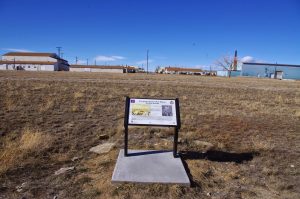
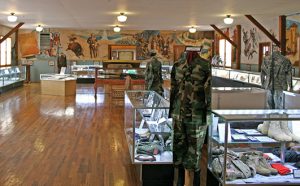 tragedy of the Casper Mountain bomber crash that I am certain was the crash that my then 8-year-old mother, Collene (Byer) Spencer witnessed. The base was also witness to the adventures of renowned test pilot Chuck Yeager, and saw the time that comedian Bob Hope paid a visit to the soldiers stationed there.
tragedy of the Casper Mountain bomber crash that I am certain was the crash that my then 8-year-old mother, Collene (Byer) Spencer witnessed. The base was also witness to the adventures of renowned test pilot Chuck Yeager, and saw the time that comedian Bob Hope paid a visit to the soldiers stationed there.

